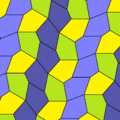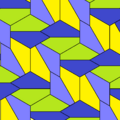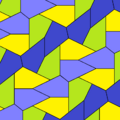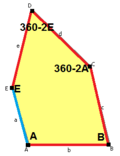Marjorie Rice facts for kids
Quick facts for kids
Marjorie Rice
|
|
|---|---|
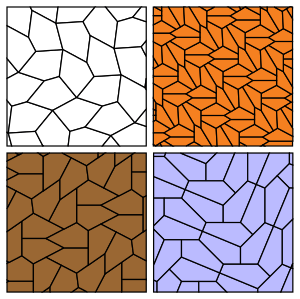
Four of Rice's pentagon tilings
|
|
| Born |
Marjorie Jeuck
February 16, 1923 St. Petersburg, Florida
|
| Died | July 2, 2017 (aged 94) San Diego, California
|
| Nationality | American |
| Occupation | amateur mathematician |
| Known for | Discovery of new tessellating pentagons |
Marjorie Ruth Rice was an American woman who loved math. She became famous for finding new ways to fit five-sided shapes, called pentagons, together perfectly. This is known as pentagonal tiling in geometry. Marjorie Rice was born on February 16, 1923, in St. Petersburg, Florida. She passed away on July 2, 2017, in San Diego, California.
Contents
Getting Started with Math Discoveries
Marjorie Rice was a mom from San Diego with five children. She loved reading a column called "Mathematical Games." This column was written by Martin Gardner and appeared every month in Scientific American magazine. Rice would rush to get the magazine first, even before her son who also subscribed!
In 1975, Rice read an article by Gardner about shapes that can fit together. These shapes fill a flat surface, called a plane, without any gaps or overlaps. This is known as "tiling the plane." Gardner wrote that finding all these shapes was finished in 1967. He mentioned that a mathematician named Richard Kershner had found three new types of five-sided shapes (pentagons) that could tile.
However, soon after, Gardner learned that Kershner was wrong. Another reader, Richard James III, found a brand new way a pentagon could tile. Gardner shared this exciting news in his December 1975 column.
Marjorie Rice's Amazing Discoveries
This new discovery inspired Marjorie Rice. Even though she only had a high school education, she decided to try and find more new pentagon tilings herself. She had a strong interest in art and began spending her free time on this challenge. She would draw diagrams on her kitchen table. If her family or friends came home, she would quickly hide her work!
Rice even created her own special system of symbols to keep track of the sides and angles of the pentagons. By February 1976, she had found a new type of pentagon and many ways it could tile. She sent her discoveries to Martin Gardner using her unique notation.
Gardner then sent Rice's work to Doris Schattschneider. Schattschneider was an expert in tiling patterns. At first, she was unsure because Rice's notation looked like "hieroglyphics." But after looking closely, she realized Rice's discoveries were correct!
Over the next few years, Marjorie Rice found many more ways to tile with pentagons.
- By October 1976, she had discovered 58 new pentagon tilings. Most of these were completely new to mathematicians.
- By December 1976, she found two more new types of tiling pentagons. She also found over 75 different ways these pentagons could fit together.
- In December 1977, she made her fourth discovery of a new pentagon type. By then, she had listed 103 different pentagon tilings.
Rice continued to explore tiling patterns for many years. She had always loved art and had even taken a course in commercial art. She often thought about how to use her pentagon tilings as patterns for drawing flowers, shells, butterflies, and bees.
Martin Gardner never published Rice's discoveries in his Scientific American columns. However, he did include them in a book of his columns published in 1988. He called her discoveries "fantastic achievements."
Much of Rice's detailed work was not published. But some of her investigations are shown in a book called The Mathematical Gardner. This book celebrates Martin Gardner's work. It includes an article by Doris Schattschneider that talks about Rice's pentagon tiling findings.
Marjorie Rice's original papers and materials are kept at the University of Calgary Library in Alberta, Canada. They are part of the Eugène Strens Recreational Mathematics Collection.
Four Types of Pentagons Marjorie Rice Discovered
How Marjorie Rice Was Recognized
Doris Schattschneider helped share Marjorie Rice's discoveries about pentagon tiling. Schattschneider praised Rice's work as an exciting find by someone who loved math, even though she wasn't a professional mathematician.
In 1995, Schattschneider convinced Rice and her husband to come to a meeting. It was a regional meeting of the Mathematical Association of America in Los Angeles. Schattschneider gave a talk about Rice's work. At the end, she introduced Marjorie Rice. "And everybody in the room . . . gave her a standing ovation." It was a huge moment of recognition for her amazing contributions!
Marjorie Rice's Lasting Impact
- In 1999, one of the tiling patterns Rice discovered was made into real ceramic tiles. These tiles were installed in the entrance hall of the Mathematical Association of America headquarters in Washington, D.C..
- Marjorie Rice's papers and materials about her math discoveries are kept safe. They are part of a special collection at the University of Calgary Library in Alberta, Canada.
Personal Life
Marjorie Ruth Jeuck married Gilbert Rice.
See also
 In Spanish: Marjorie Rice para niños
In Spanish: Marjorie Rice para niños


